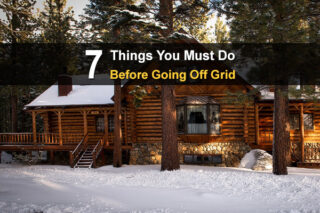This post may contain affiliate links.* As an Amazon Associate I earn from qualifying purchases. Click here to read our affiliate policy.
If you're prepper or homesteader who also loves coffee, then at some point you probably asked yourself, “How can I drink coffee while living off the grid?” If going to the grocery store or a coffee shop isn't an option, you'll need another way to feed your addiction.
Of course, you can stockpile coffee grounds, but those only last a few months. Most coffee beans will last six to eight months, but what if you're going to live off the grid indefinitely? For that, the answer is green coffee beans. When stored properly, they will last up to 20 years.
In this video, Jamie from Guildbrook Farm shows you how to roast green coffee beans. To do this, you'll need:
- Burner
- A pot
- A large cookie sheet
- A manual coffee grinder
- A French press
- A pocorn popper
Here's what to do:
- Turn on the burner to medium-low heat and put the popcorn popper on it.
- Pour half a pound of green coffee beans into it and start stirring them with the hand crank.
- Keep stirring them for several minutes until you hear the first “crack”.
- Once you hear that first crack, you can remove them. You can wait a little longer, but be careful because they will get dark really fast. You may want to turn the heat down.
- Dump the beans onto the cookie sheet so they can cool off. If you want, you can leave some of the beans in the popper and put it back on the burner to get a dark roast. Once you hear several cracks, it is getting close to burning so don't leave it on too much longer.
- Once the beans have cooled off, you can make coffee. Pour two cups of water into the pot and place it on the burner.
- Put your coffee beans in the grinder and grind them up (4 tablespoons per 2 cups of coffee).
- Put your coffee grounds into the French press. Once the water is boiling, pour it into the French press.
- Let it sit for about seven minutes, then push the plunger down and your coffee is ready to drink!
Watch the video below to see how it's done.













Best done outside. The smoke from roasting the beans do an have the pleasant coffee aroma you may think. Plus it can can get quit smoky going from a light roast to a medium roast etc. make sure to toss the roasted beans to allow the chaff to blow away or you end up brewing a horrible tasting cup of coffee. The chaff is the outer layer of the bean, make sure you get rid as much chaff as possible. It’s light so tossing them lightly while blowing across the beans will do the trick.
Is it possible to buy your favorite blend in un-roasted form?
Are there people/companies that sell this sort of thing?
Thanks for the great article. As a coffee importer, roaster, and aficionado I would just die if we didn’t have our favorite beverage. Luckily, we always have about 700-900 pounds at home.
There are many sellers of green coffee beans. Our site is alittlefurthersouth.com. The old rule of thumb is about 15-18 months for best flavor from green coffee, however personally, we have roasted coffee that was 6-7 years old & found it slightly less flavorful than “new,” but still good. The main enemies of freshness are light & oxygen. Store your coffee in a dark, cool place and in a airtight container.
In my experience, the French Press makes the smoothest coffee when used for 3-4 minutes. The longer time will make a stronger brew, but has the potential to be bitter.
OK, we have the way to turn those green beans into coffee… my reading of the link was “you can store green coffee for years…”.
Most know how to roast and grind coffee, but storing those beans for a possible long “winter” – the part that is probably least understood – was not here.
Almost feel like i got click-baited.
I do not think im in the minority here that came here wanting the info about sourcing green coffee and storage methods.
In what way were you click-baited? The title of the post says “coffee roasting and brewing,” and that’s exactly what the post and video describe.